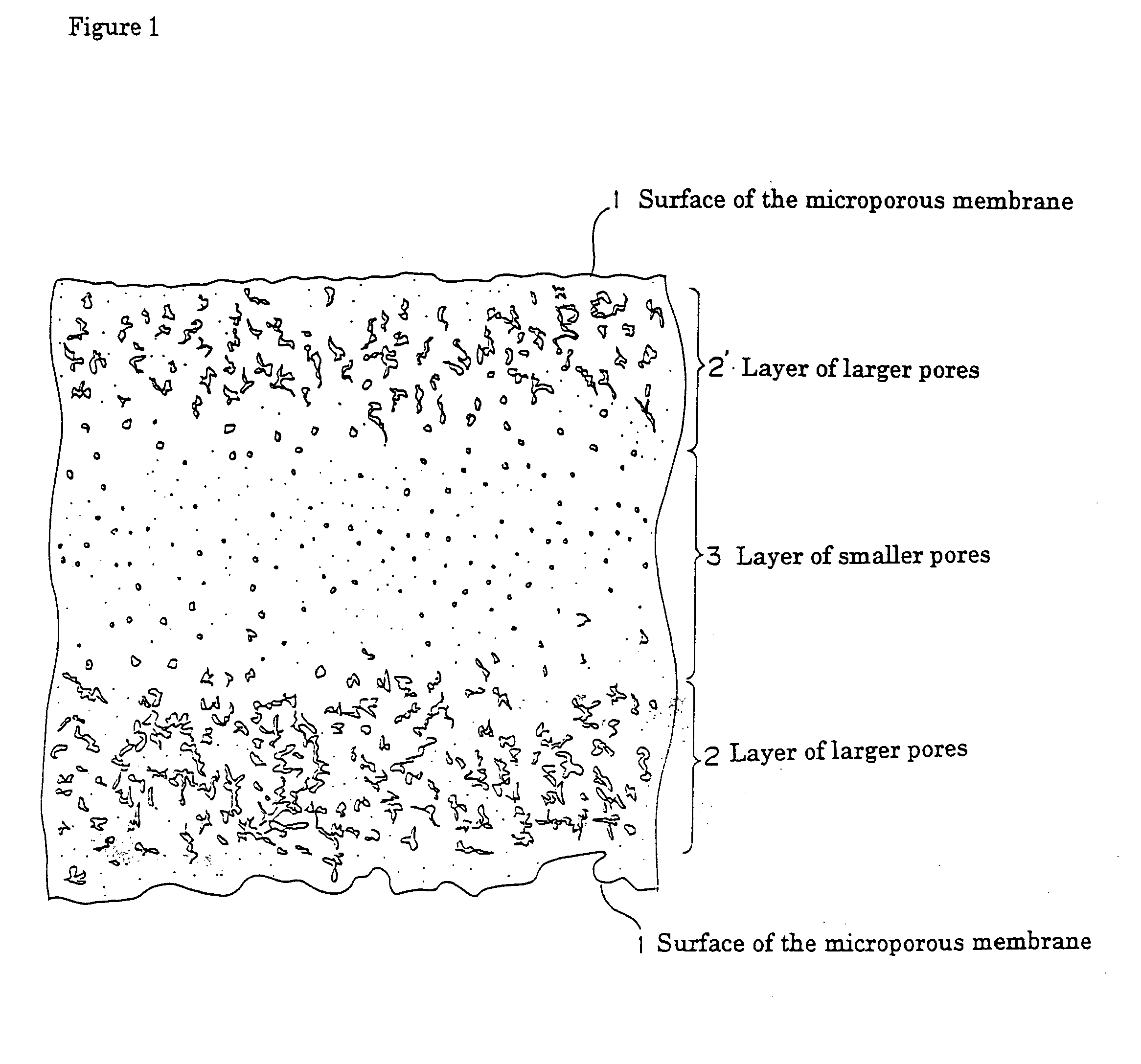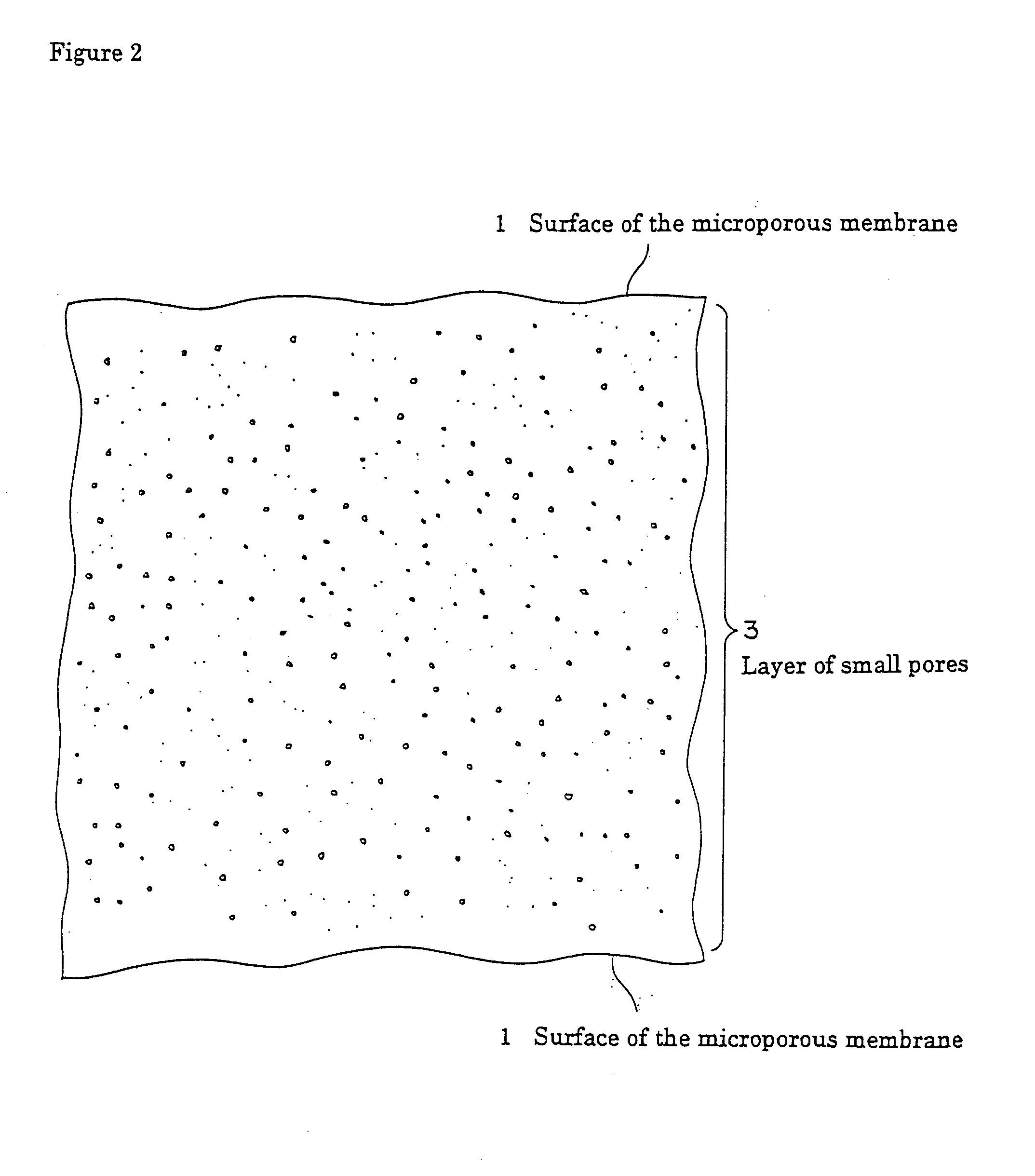Microporous polyolefin membrane, and method of producing the same
a polyolefin and microporous technology, applied in the field of microporous membranes, can solve the problems of increased inner resistance of the battery and difficulty in control, and achieve the effect of controlling the pore size and porosity of the membran
- Summary
- Abstract
- Description
- Claims
- Application Information
AI Technical Summary
Benefits of technology
Problems solved by technology
Method used
Image
Examples
example 1
[0061] A polyethylene composition (melting point: 135° C., crystal dispersion temperature: 90° C.) having an Mw / Mn ratio of 14, composed of 20 weight % of an ultra-high-molecular-weight polyethylene (UHMWPE) having a weight-average molecular weight of 2.5×106 and 80 weight % of a high-density polyethylene (HDPE) having a weight-average molecular weight of 3.0×105 was incorporated with 0.08 weight parts of a phenol-based antioxidant and 0.08 weight parts of phosphorus-based antioxidant, all based on 100 weight parts of the polyethylene composition, to prepare a polyethylene composition. Twenty (20) weight parts of the polyethylene composition was fed to a biaxial extruder (58 mm in diameter, L / D ratio=42, high kneading type segment), and 80 weight parts of liquid paraffin was also fed to the biaxial extruder from the side feeder, to prepare a polyethylene solution in the extruder by melting the polyethylene composition and kneading it with the liquid paraffin at 200° C. and 200 rpm. ...
example 2
[0063] A polyethylene composition (melting point: 135° C., crystal dispersion temperature: 90° C.) having an Mw / Mn ratio of 14, composed of 20 weight % of an ultra-high-molecular-weight polyethylene (UHMWPE) having a weight-average molecular weight of 2.5×106 and 80 weight % of a high-density polyethylene (HDPE) having a weight-average molecular weight of 3.0×105 was incorporated with 0.08 weight parts of a phenol-based antioxidant and 0.08 weight parts of phosphorus-based antioxidant, all based on 100 weight parts of the polyethylene composition, to prepare a polyethylene composition. Twenty (20) weight parts of the polyethylene composition was fed to a biaxial extruder (58 mm in diameter, L / D ratio=42, high kneading type segment), and 80 weight parts of liquid paraffin was also fed to the biaxial extruder from the side feeder, to prepare a polyethylene solution in the extruder by melting the polyethylene composition and kneading it with the liquid paraffin at 200° C. and 200 rpm. ...
example 3
[0067] A polyethylene composition (melting point: 135° C., crystal dispersion temperature: 90° C.) having an Mw / Mn ratio of 14, composed of 20 weight % of an ultra-high-molecular-weight polyethylene (UHMWPE) having a weight-average molecular weight of 2.5×106 and 80 weight % of a high-density polyethylene (HDPE) having a weight-average molecular weight of 3.0×105 was incorporated with 0.08 weight parts of a phenol-based antioxidant and 0.08 weight parts of phosphorus-based antioxidant, all based on 100 weight parts of the polyethylene composition, to prepare a polyethylene composition. Twenty (20) weight parts of the polyethylene composition was fed to a biaxial extruder (58 mm in diameter, L / D ratio=42, high kneading type segment), and 80 weight parts of liquid paraffin was also fed to the biaxial extruder from the side feeder, to prepare a polyethylene solution in the extruder by melting the polyethylene composition and kneading it with the liquid paraffin at 200° C. and 200 rpm. ...
PUM
| Property | Measurement | Unit |
|---|---|---|
| Percent by mass | aaaaa | aaaaa |
| Percent by mass | aaaaa | aaaaa |
| Percent by mass | aaaaa | aaaaa |
Abstract
Description
Claims
Application Information
 Login to View More
Login to View More - R&D
- Intellectual Property
- Life Sciences
- Materials
- Tech Scout
- Unparalleled Data Quality
- Higher Quality Content
- 60% Fewer Hallucinations
Browse by: Latest US Patents, China's latest patents, Technical Efficacy Thesaurus, Application Domain, Technology Topic, Popular Technical Reports.
© 2025 PatSnap. All rights reserved.Legal|Privacy policy|Modern Slavery Act Transparency Statement|Sitemap|About US| Contact US: help@patsnap.com



